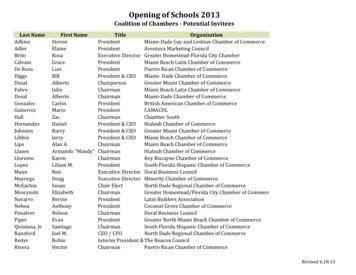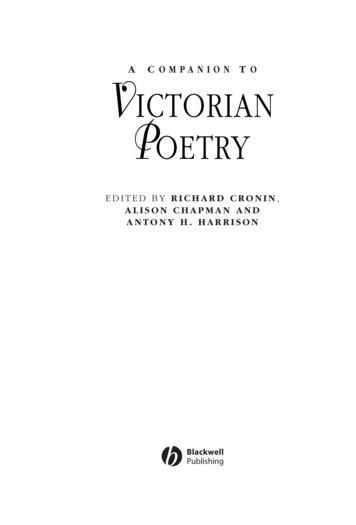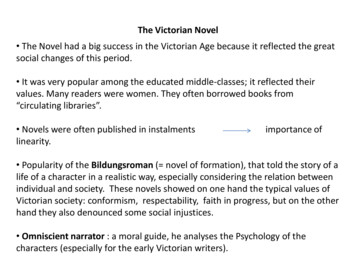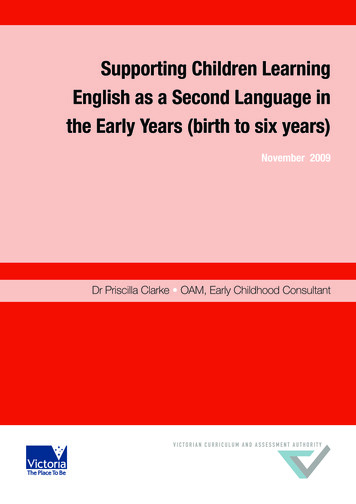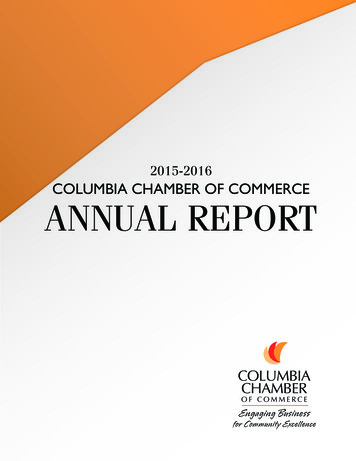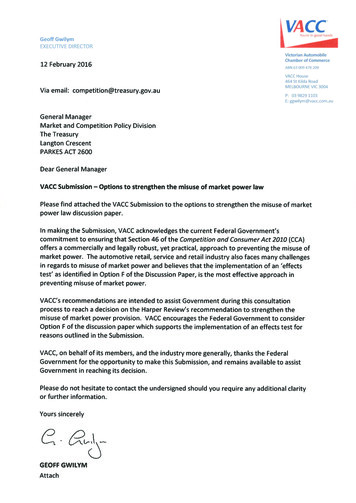
Transcription
VACC SubmissionOptions to strengthen the misuseof market power lawFebruary 2016Submitted by the Victorian Automobile Chamber of Commerce
ContentsAbout VACC3Background of the automotive industry3Executive Summary4VACC Position6Misuse of market power within the automotive industry7Proposed legal description for section 462VACC Submission Options to strengthen the misuse of market power law12
About VACCThe Victorian Automobile Chamber of Commerce (VACC) is Victoria’s peak automotiveindustry association, representing the interests of more than 5,000 members in over 20retail automotive sectors that employ over 50,000 Victorians.VACC members range from new and used vehicle dealers (passenger, truck, commercial,motorcycles, recreational and farm machinery), repairers (mechanical, electrical, bodyand repair specialist, i.e. radiators and engines), vehicle servicing (service stations, vehiclewashing, rental, windscreens), parts and component wholesale/retail and distribution andaftermarket manufacture (i.e. specialist vehicle, parts or component modification and/ormanufacture), and automotive dismantlers and recyclers. In addition to VACC, its sisterorganisations – the Motor Trade Associations, represent the automotive industry for theirrespective states.Background of the automotive industryThe automotive industry contains approximately 65,000 businesses nationally, the vastmajority of which (95%) are small and family owned and operated businesses.For the year ended June 2014, aggregate employment for the industry was recorded at383,806 persons.1 In gross domestic product (GDP), the automotive industry as a wholeaccounted for approximately 38.3 billion or 2.5% of Australia’s annual GDP in currentprices in 2012-13.2The industry is very competitive with small profit margins, consumer behaviour limitscapacity of industry to raise prices, large multi-nationals (insurance companies, the oilindustry, supermarkets, vehicle manufacturers) heavily influence consumer behaviourand/or price. The cost of doing business is high due to rapid vehicle technology advancesrequiring high-level skills and expensive technology in the repair service process.¹ Auto Skills Australia, Automotive Environmental Scan 2015² Ibid3VACC Submission Options to strengthen the misuse of market power law
Executive SummaryIn regards to section 46 of the Consumer and Competition Act (CCA) 2010, relating tothe misuse of market power, the VACC strongly supports the full set of amendments asoutlined in Recommendation 30 of the Harper Panel, which is identified as Option F in theGovernment Discussion Paper, Options to Strengthen the Misuse of Market Power Law.The VACC supports Option F for the following reasons: There is evidence of systemic abuse of market power within the automotiveindustry that is damaging competition, service provision and consumer welfare; Legal advice provided to VACC suggests there is little chance of undertakingsuccessful action against such market conduct within the current framework of lawcontained in section 46; Adoption of the Harper Panel’s amendments as detailed in Recommendation 30would harmonise section 46 with other sections of the CCA, namely section 45,section 47 and section 50; The Harper Panel amendments contained in Recommendation 30 wouldharmonise section 46 with international competition laws as evident in the EU,USA and Canada.Anti-competitive conduct within the automotive industryThe following are examples of anti-competitive and damaging business conduct withinthe automotive industry, for which there is little redress for affected businesses within thecurrent framework of the law. The full details of these cases are discussed within the body ofthis submission.Vehicle Body RepairsWidespread and extensive reports from VACC member business indicate that the verticalintegration of vehicle body repair activity within the operations of insurance companies isdamaging the overall health and competitiveness of the vehicle body repair market.This is manifested through vastly reduced work allocations by insurers to established vehiclebody repair businesses, thereby reducing their viability and resulting in the closure ofmany hundreds of body repair businesses nationally. This also has negative implications forconsumer choice and the quality and diversity of repairs that are available within the market.Mechanical Repair and servicingAccess to manufacturer technical information for the service and repair of vehicles and theinstallation of parts is not made available to all independent mechanical repairers, not evenfor a reasonable fee. This is damaging the level of competitiveness within the vehicle serviceand repair market by unfairly restricting the ability of independent repairers to undertakevehicle repairs. This has resulted in the closure and exit of many hundreds of independentrepairers from the market.This also negatively impacts on consumer choice, forcing consumers to seek dealershipservicing and repairs to their vehicles only at businesses who have access to repairinformation and this can add significantly to the cost of repairs. Consumers in rural areashave limited access to choice of repairer and often must travel excessive distances forservicing or repair.4VACC Submission Options to strengthen the misuse of market power law
MotorcyclesVACC has received numerous reports from members of unfair and damaging businessconduct from motorcycle manufacturers towards their affiliated dealerships. Thesepractices include restrictions on the selling of product lines and the cancellation of franchiseagreements with business owners with no warning. These behaviours are damagingthe sustainability and competitiveness of many franchise operators, particularly in ruralcommunities, and represent not only a misuse of market power but a severe powerimbalance in the relationship between franchisees and franchisors.Automotive Components Sector – Glass SupplyVACC has received reports from members of predatory pricing behaviour and anticompetitive conduct from businesses with substantial market share in both the importationand fitting of automotive glass. Small and independent business owners do not have theresources to combat this misuse of market power, with the likely effect being that they willexit the industry as their businesses will no longer be viable.Fuel supplyVACC independent service station members had achieved limited success with the ACCC, incombating supermarket practices of offsetting fuel prices through store sales, with the lureof shop-a-dockets.Summary PositionVACC strongly believes that adopting the full set of amendments to competition law asproposed by the Harper Panel in Recommendation 30, is the most practical, commerciallyand legally robust way forward to address systemic abuse of power of market power withinthe automotive industry and the broader economic environment.VACC supports the adoption of the model section 46 provision as set out in the CompetitionPolicy Review Final Report and as such, has included it as part of this submission.5VACC Submission Options to strengthen the misuse of market power law
VACC PositionIn relation to section 46 of the Consumer and Competition Act 2010, relating to the misuseof market power, the VACC strongly supports the full set of amendments as outlined inRecommendation 30 of the Harper Panel, which is identified as Option F in the GovernmentDiscussion Paper, Options to Strengthen the Misuse of Market Power Law.As a matter of policy, VACC believes that there needs to be a practical way forward, andone that is commercially and legally robust to prevent the misuse of market power in theAustralian business economy. It therefore should be the case that competition law shouldbe directed to the effect of commercial conduct on competition and ultimately consumerwelfare. The current misuse of market power provision is framed in a manner that doesnot deter anti-competitive behaviour by firms with substantial market power, and this isreflected in the automotive industry.Outlined in this submission are key examples of corporations with a substantial degree ofmarket power that utilise this power not for the purpose of damaging any single competitor,but to the level of competitiveness in the market. This is not a desirable outcome, andhence a more holistic interpretation of market conduct is required, beyond the ‘takeadvantage’ and ‘purpose’ provisions of section 46.VACC believes that the proposed test of ‘substantially lessening competition’ asrecommended by the Harper Panel does not represent a radical departure from othersections of the CCA. In fact this test is identical to that already found within section 45(contracts, arrangements or understandings that restrict dealings or affect competition);section 47 (exclusive dealings) and section 50 (mergers) of the CCA. As a matter of policy,harmonisation of competition laws across the CCA therefore should be a key governmentpriority.It is also the case that international competition laws as they exist in the European Union,the USA and Canada, have also been framed so as to examine the effects on competition ofcommercial conduct as well as the purpose of the conduct. The Harper Panel amendmentswould thus also better harmonise Australia’s competition laws with those of theinternational community, which is also a desirable policy objective.Given Australia’s leading role and support for international trade agreements, it wouldappear incongruent should Australia also not adopt misuse of market powers legislationthat already exist with many of our trading partners.6VACC Submission Options to strengthen the misuse of market power law
Misuse of market power within the automotive industryVehicle Body RepairsVACC’s Body Repair Division contains over 700 member companies whose primaryoperations involve vehicle body, paint and interior repair services.VACC has received numerous reports from members of practices involving the misuse ofmarket power and consequent damage to businesses by insurers within this sector. This inturn, has severely impacted the competitiveness of the sector.The past 18 years have witnessed enormous rationalisation in the Australian insurancemarket. Eleven of the largest insurers have amalgamated into just two large insurancebusinesses. In 1998 the following insurers were each fundamentally independent of theother: Suncorp AMP RACQ acquired and subsequently sold RAA acquired and subsequently sold RACT Promina Group (AAMI, Vero, APIA, Shannons, Just Car, Bingle) IAG SGIO RACV CGU Swann WesfarmersFor the body repair industry this change has been savage. In 1998 a ‘Many-To-Many’ marketexisted. Many insurers competed for many body repairers, meaning the actions of onecould not unduly affect the other.Now however the market is essentially “One-To-Many”. While many body repairers remain,for market purposes the current duopoly effectively represents one insurer. The actionsof the insurer can and do affect large swathes of the body repairers. This has seen unfairpractices employed, where repairers are forced to undercut each other on price to anunprofitable level, with the ramifications being loss of all work. In order to achieve sucha low price point, the consumer is the party losing out, as work must be completed in anoverly-expedient manner, using the lowest price parts and the cheapest possible labour.Pressures by large insurers to quickly and cheaply perform complex vehicle repairs hashad a disastrous effect on many body repairers, many of which will exit the industry in thecoming few years.The sheer scale of the current duopoly has also seen experimentation with variousvertical integration schemes, including the full-scale production of a new self-owned bodyrepair model. This model has seen numerous customer issues relating to suitability andappropriateness of repair and proximity of repair centres. It has also decimated much of the7VACC Submission Options to strengthen the misuse of market power law
market, removing the workflow for businesses who have invested heavily in infrastructure,skills and education in order to service the Australian consumer. This has resulted in theclosure of many hundreds of businesses within a very short time period.This is supported by ABS data (Table 1) which shows there has been a total net loss ofalmost 500 automotive body repair businesses nationally between 2012 and 2014. Themajority these losses are small family owned and operated businesses.Table 1 Counts of Automotive Body, Paint and Interior Repair BusinessesYear201220132014Non Employing5354500450051-19 Employees 20-199 Employees 200 122Source: ABS Counts of Australian Business Entries and Exists, June 2012 to 2014A comparison can be drawn to the duopoly existing in the Australian supermarket sector,with many examples of predatory tactics creating devastating implications for the smallsupplier with many of them unable to sustainably supply goods, meaning the ultimate loseris the Australian consumer.The Australian automotive industry is the most diverse per capita in the world, with over60 manufacturer brands represented. Australia also has one of the highest rates of carownership and is one of the least densely-populated countries in the world. These threepoints alone make the need for a robust, diverse and flexible body repair marketplace moreimportant than virtually anywhere else. It is the consumer who suffers and will continue tosuffer with the significant reduction of body repairers.The 18 year explosion of the insurance duopoly has provided them with significant financialbenefits, and with this duopoly comes a moral argument for appropriate controls to ensurea fair consumer experience and marketplace.Legal advice provided to VACC and its member businesses is that there is very little that canbe done within the current framework of the law to reduce this anti-competitive conduct.The reframing of section 46 to include the addition of an ‘Effects test’ as proposed by theHarper Panel, allows this fairness to be enforced.While VACC acknowledges the competition in the insurance industry, the current situationallows insurers to place unreasonable pressures on the repair industry and removesconsumer choice. Further, consumer interests are ignored as this pressure reduces safety,quality assurance and exposes repairers to litigation, as repairers are forced into reducedguarantee of quality work.VACC therefore wholeheartedly supports the full set of amendments as proposed inRecommendation 30 of the Harper Review. This would reframe section 46 of the CCAand prohibit corporations with substantial market power from engaging in conduct thatsubstantially lessens competition in the market.Mechanical Repair and ServicingVACC has received numerous reports across its membership base, of unfair and damagingbusiness practices within the automotive servicing and mechanical repair market.8VACC Submission Options to strengthen the misuse of market power law
The conduct is associated with vehicle manufacturers and their affiliated dealerships andthe fair provision of technical repair and servicing information to the automotive repairmarket more broadly.Access to manufacturer information for the service and repair of vehicles and theinstallation of parts is not made available to many independent mechanical repairers, noteven for a reasonable fee. This is damaging the level of competition with the vehicle serviceand repair market by pushing small independent repairers out of business, as well as forcingconsumers to seek costly servicing and repairs at the service centres who are affordedaccess to information.A key example of these practices includes the following:a. An independent repairer identifies a faulty component –a climate control module-andpurchases a replacement from the manufacturer’s dealer for 1200.b. The module needs to have a ‘scan tool’ plugged in to apply the correct settings, e.g.read ‘Celsius’, set car to be Right Hand Drive.c. The independent repairer has their own scan tool, however the manufacturer/dealerwill not provide the codes to apply the correct settings.d. Either the customer now needs to go to the dealer to have the settings applied, or therepairer takes the car to the dealer and pay an additional fee ( 200) to have the settingsapplied.Such practices have reduced the profitability and viability of the independent vehicle repairmarket, forcing the closure of many hundreds of businesses over a very short time period.Again this is supported by ABS data (Table 2) which shows there has been a net loss ofalmost 400 businesses nationally between 2012 and 2014.Table 2 Counts of Vehicle Mechanical Repair BusinessesYear201220132014Non Employing9851947294031-19 Employees 20-199 Employees 200 022239Source: ABS Counts of Australian Business Entries and Exists, June 2012 to 2014Legal advice provided to VACC and its member businesses is that there is very little that canbe done within the current framework of the law to reduce this anti-competitive conduct.In the European and US markets, competition law exists to prevent such anti-competitivepractices and abuse of company’s dominant market positions. At the very least, access totechnical repair information should be made available at a fair and reasonable price to alllegitimate repair businesses seeking to provide consumer services.Motorcycle RetailingVACC has received numerous reports from member businesses of unfair and damagingbusiness conduct from motorcycle manufacturers towards their affiliated dealerships.Key examples of these practices includes the following:a. A VACC member owns and operates a successful motorcycle dealership in a largeVictorian country town9VACC Submission Options to strengthen the misuse of market power law
b. The manufacturer makes an internal decision to remove All Terrain Vehicles (ATVs) fromits motorcycle range and move to farm machineryc. The franchisee adheres to this, removing ATVs from his/her sales floord. To make up for the loss of product-line, he/she takes on another smaller Chinesemanufacturere. Later, the original manufacturer comes back and decides to reinstate ATVs and instructsour member to remove the Chinese bikes and place ATVs theref. The member objects as Chinese bikes are now an established part within his/herbusiness, but says he/she will add ATVs as wellg. The manufacturer cancels his franchise agreement and signs another business to be thenew dealer.Such conduct is not only anti-competitive but can also ruin the social fabric within regionalcommunities. In this situation, there is little recourse for the affected business owner underthe current misuse of market power provision contained in section 46 of the CCA.There is also evidence that these practices are reducing small business numbers within themotorcycle market as shown in Table 3.Table 3 Counts of Motorcycle Retail BusinessesYear201220132014Non Employing3853413161-19 Employees 20-199 Employees 200 Employees559233516253532293Total970885880Source: ABS Counts of Australian Business Entries and Exists, June 2012 to 2014It is imperative that fairer and more balanced provisions be adopted within section 46,pertaining to those with substantial market power and the damage they can inflict withina market. VACC strongly believes that adoption of the Harper Panel amendments wouldhelp restore fairness and balance in the business arrangements between franchisors andfranchisees.Automotive Components Sector – Glass Supply and InstallationVACC has also received reports from members of predatory pricing behaviour and anticompetitive conduct from businesses with substantial market share in both the importationand fitting of automotive glass.Australia’s last automotive glass manufacturing facility closed in late 2015. All automotiveglass is imported into Australia by a number of suppliers that distribute into the glass fittingsector.One supplier with a substantial market share is now engaging in predatory pricing bysupplying the market with below-cost automotive glass. The perceived aim of this conductis to strengthen its position in the market place at the expense of its competitors.Similarly, there are reports of insurance companies engaging in behaviour that limits thepolicy holder’s freedom of choice to choose their own repairers for the installation ofautomotive glass. Specifically, they are strongly encouraging policy holders to travel to their10VACC Submission Options to strengthen the misuse of market power law
own insurer aligned workshops, which may be of considerable distance and inconvenienceat the expense of a local independent glass fitter.Both these examples highlight the impact on independently owned small businesses andultimately the consumer. Small and independent business owners do not have the resourcesto combat this misuse of market power, with the likely effect being that they will exit theindustry as their businesses will no longer be viable.The direct impact on the consumer, in the face of reduced competition, will likely be highercosts in the long term and potentially poorer quality of repairs. The consumer’s choice hasbeen significantly reduced from this scenario and this works against an expectation in thecommunity that consumers have the purchasing power in matters relating to the serviceand repair of their vehicles.11VACC Submission Options to strengthen the misuse of market power law
Proposed legal description for section 46Below is the Competition Policy Review Final Report’s proposed section 46. VACC believesthat the Government should adopt this model provision. The introduction of an effectstest will ensure a more simplified section 46 that will enhance, rather than penalise,competition.(1) A corporation that has a substantial degree of power in a market shall not engage inconduct if the conduct has the purpose, or would have or be likely to have the effect, ofsubstantially lessening competition in that or any other market.(2) Without limiting the matters that may be taken into account for the purposes ofsubsection (1), in determining whether conduct has the purpose, or would have or belikely to have the effect, of substantially lessening competition in a market, the courtmust have regard to:(a) the extent to which the conduct has the purpose, or would have or be likely to havethe effect, of increasing competition in the market including by enhancing efficiency,innovation, product quality or price competitiveness in the market; and(b) the extent to which the conduct has the purpose, or would have or be likely to havethe effect, of lessening competition in the market including by preventing, restrictingor deterring the potential for competitive conduct in the market or new entry into themarket.(3) If:(a) a body corporate that is related to a corporation has, or 2 or more bodies corporateeach of which is related to the one corporation together have, a substantial degreeof power in a market; or(b) a corporation and a body corporate that is, or a corporation and 2 or more bodiescorporate each of which is, related to that corporation, together have a substantialdegree of power in a market;the corporation shall be taken for the purposes of this section to have a substantialdegree of power in that market.(4) In determining for the purposes of this section the degree of power that a bodycorporate or bodies corporate has or have in a market, the court shall have regardto the extent to which the conduct of the body corporate or of any of those bodiescorporate in that market is constrained by the conduct of:(a) competitors, or potential competitors, of the body corporate or of any of thosebodies corporate in that market; or(b) persons to whom or from whom the body corporate or any of those bodies corporatesupplies or acquires goods or services in that market.12VACC Submission Options to strengthen the misuse of market power law
(5) In determining for the purposes of this section the degree of power that a bodycorporate or bodies corporate has or have in a market, the court may have regardto the power the body corporate or bodies corporate has or have in that market thatresults from any contracts, arrangements or understandings, or proposed contracts,arrangements or understandings, that the body corporate or bodies corporate has orhave, or may have, with another party or other parties.(6) Subsections (4) and (5) do not limit the matters to which regard may be had indetermining, for the purposes of this section, the degree of power that a body corporateor bodies corporate has or have in a market.(7) For the purposes of this section, a body corporate may have a substantial degree ofpower in a market even though:(a) the body corporate does not substantially control the market;(b) the body corporate does not have absolute freedom from constraint by the conductof:(i) competitors, or potential competitors, of the body corporate in that market; or(ii) persons to whom or from whom the body corporate supplies or acquires goods orservices in that market;(c) one or more other bodies corporate have a substantial degree of power in thatmarket.(8) In this section:(a) a reference to power is a reference to market power;(b) a reference to a market is a reference to a market for goods or services; and(c) a reference to power, or to conduct, in a market is a reference to power, or toconduct, in that market either as a supplier or as an acquirer of goods or services inthat market.Alternative options in the Discussion PaperVACC does not support the alternative options presented due to concerns that practices asdescribed in our submission would lack legitimate recourse to legal protections, with theintention of protecting competition.Concluding remarksIt is VACC’s view that without the introduction of the effects test as outlined in the HarperReview, behaviour of the corporations as described will continue forcing small competitorsfrom the market, reducing consumer choice and standards of repair of motor vehicles willjeopardise safety of the consumer and public. VACC is not arguing for protectionism, rathera balance to the legislation and competition in the market.13VACC Submission Options to strengthen the misuse of market power law
Promina Group (AAMI, Vero, APIA, Shannons, Just Car, Bingle) IAG SGIO RACV CGU Swann Wesfarmers For the body repair industry this change has been savage. In 1998 a 'Many-To-Many' market existed. Many insurers competed for many body repairers, meaning the actions of one could not unduly affect the other.


